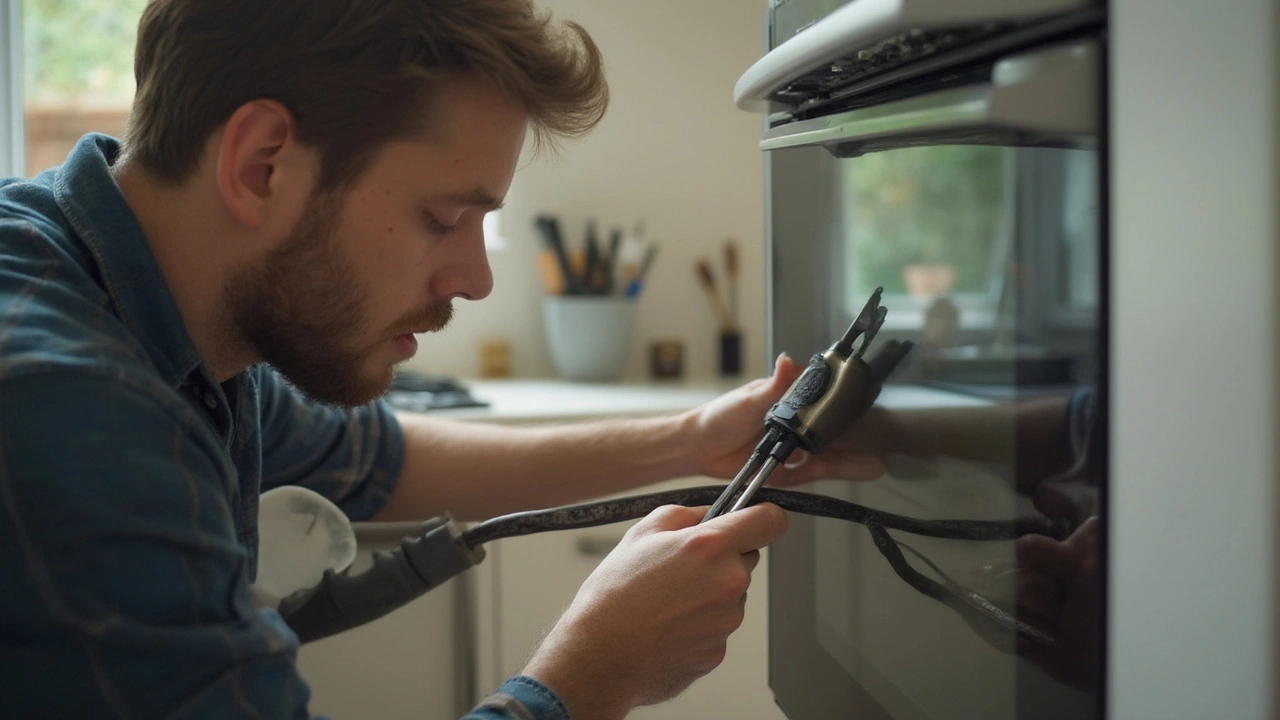You’re halfway through cooking dinner and suddenly the electric oven just quits. The preheating beeper goes silent. The light’s off. What now? Most folks think their oven just up and died for no reason, but there’s almost always something simple behind the blackout. The worst part? You don’t know if it’s an easy fix or you’re in for a new appliance.
Common Reasons Your Electric Oven Suddenly Stops Working
When an electric oven stops working out of nowhere, it's usually just one or two things. The irony is, most breakdowns aren’t dramatic at all. They sneak up because of tiny, overlooked faults. Still, a dead oven is a pain, especially if you bake a lot or have family dinner riding on it.
An electric oven runs on a pretty straightforward system. Power comes from a dedicated circuit. It heats up using metal heating elements. It’s got a thermostat to regulate temperature and a few controls on the front. Each of those has its own potential to fail.
Statistically, the most common cause is a tripped circuit breaker or a blown fuse. According to the U.S. Consumer Product Safety Commission, more than 60% of home kitchen appliance service calls are solved at the fuse box. A surge or a shorted-out wire inside the oven could easily pop the breaker. If you’re lucky, flipping it back solves everything—just don’t forget to reset digital clocks and timers.
If it isn’t a power problem, it might be the door switch. Modern ovens won’t turn on if they think the door’s open, even just a sliver. Kids, a banged-up latch, or years of slamming the door can all lead to a faulty door switch. And unless you look—really look—you probably won’t spot it. Try pressing the switch with a screwdriver and see if anything happens.
Burned-out heating elements are another sneaky culprit. These usually go out with a literal bang or small pop, but sometimes they just fade away. When the heating element’s done, so is your oven's ability to create heat. A visual inspection works: see a break, bubble, or burnt spot on the metal coil, and you likely found your problem. If both the bake and broil elements look fine, the issue's probably deeper.
Control boards and thermostats can also fail, but it’s less common unless your oven's seen many years of use or a recent power surge. A classic sign: oven lights up but never heats, or it stays cold and unresponsive. That means the brain isn’t sending the right signals, so even if everything else works, you’re left with a dead box.
Here’s a breakdown of typical causes and what percentage they represent in household electric oven failures:
| Cause | Percentage of Cases |
|---|---|
| Tripped Circuit Breaker | 38% |
| Faulty Heating Element | 22% |
| Malfunctioning Door Switch | 14% |
| Control Board Issues | 11% |
| Wiring/Loose Connections | 10% |
| Thermostat Failure | 5% |
Ever notice a burning smell or see sparks right before the oven stops working? That’s a warning sign. It could mean insulation on a wire finally gave out or the element shorted. Make sure to unplug or turn off the breaker before touching anything if you see or smell something weird.
DIY Troubleshooting Steps You Can Try Before Calling For Help
A dead oven doesn’t mean you have to panic and call in an expert right away. You actually have a decent shot at fixing it yourself. The trick is knowing where to look and what NOT to touch (hint: don’t start poking around unless you’ve switched off the breaker, nobody needs a shock for dinner).
- Check the power first. Go to your home's breaker panel and look for a flipped breaker. Give it a reset. If it flips again, you’ve got an electrical short—stop and call an electrician.
- Look for simple clues—any error codes flashing on the display? Sometimes, a stuck button or child lock feature can shut things down. Most oven manuals list what their codes mean, and a quick search can help if you've lost the booklet.
- Inspect the oven’s plug (if it has one). Over the years, plugs and outlets can burn out, especially those tucked behind big, hard-to-move ovens.
- Open the oven door and check the switch. Press it a few times; if it feels loose or doesn’t click, it could be jammed or broken. Some models use a tiny, plastic actuator that breaks with force.
- Give the heating coils a once-over. They should be smooth and unbroken. Damage here means the element needs replacing.
- Use a multimeter (if you have one) to check for continuity in the heating element, door switch, or fuse, but don’t risk it if you’re not familiar—a replacement element for most standard ovens runs less than $40.
Be careful with anything inside the oven's main cavity. Panels might look easy to unscrew, but dozens of models hide live wiring and sensors behind there. And the control board itself can be expensive; if you must replace it, weigh that cost against just picking up a new oven (especially if yours is over 15 years old).
One pro tip? If your oven has a digital control display, try unplugging it for five minutes (or flipping the breaker off) and power it back up. Sometimes, software glitches freeze up these modern brains. Resetting can bring it back to life.
If you have gas at home but your oven’s electric, double-check that you aren’t mistaking a house-wide issue. Apartments sometimes run a single heavy-duty circuit to every kitchen, and a neighboring problem can blow your breaker, too.

Common Misconceptions and Mistakes People Make With Their Ovens
One of the biggest myths is that electric ovens need regular servicing like a car. In reality, they’re built to last, but the problems start when folks ignore small warning signs. A slow preheat, uneven baking, or that weird hot smell—these often get brushed aside until the oven stops cold.
Another misconception: replacing parts is hard or dangerous. Swapping out a heating element or door switch is usually simple if the oven’s unplugged and you stick to what’s visible. Most manufacturer websites have video guides now. Big mistake? Forgetting to photograph how the parts fit before you take things apart. There’s nothing worse than reassembling your oven and finding leftover screws.
Some people also think a broken oven means you need a brand new one. In reality, most repairs for sudden shutdowns cost between $50 and $220, which is much less than a $1,200 replacement. Be wary if you get quoted much higher—double-check the diagnosis, unless you see obvious signs of fried wiring or a blown control board.
Don't ignore safety rules, though. Never work on your oven while it's plugged in. Don’t try to force doors or knobs. Also, don’t spray cleaners behind the control panel—one unlucky squirt can fry sensitive electronics.
People sometimes get creative and use extension cords to test dead outlets. Avoid this! Electric ovens need a ton of power, and using the wrong cord or socket can cause damaging surges or fire hazards. Use only the proper dedicated circuit for your oven, or wait for a pro.
Folks also ask if an oven running but not heating is the same as an oven that's totally dead. Not really. If lights and clocks work, but there's no heat, it's almost always the heating element or thermostat. If it’s unresponsive in every way, start your troubleshooting at the power supply or breaker.
Remember, a surprising number of issues come from something really simple—like someone setting the controls to "timer" without realizing it, then panicking when the oven won’t turn on. Don’t skip the obvious stuff.
When to Repair, When to Replace, and How to Prevent Future Surprises
A sudden kitchen crisis has a way of making you rethink your appliances. Sometimes, the question isn’t just “Why did my oven stop?” but, “Is it even worth trying to fix?”
Here's a good rule of thumb: if your oven is under eight years old and the repair will cost less than half a new one, go for the fix. If it's older or has failed multiple times on different parts, a replacement may save you headaches (and money) in the long run. Ovens made after 2016 tend to have more complex digital parts, so keep in mind repair costs can spike just for control board swaps.
For basic electric ovens, nearly 70% of callouts in 2024 involved a single failed part or loose wire—usually fixed on the spot within an hour. Most brands keep replacement elements and switches in ready supply, so waiting weeks for parts is rare.
How do you head off problems before they begin? Start by giving your oven a thorough clean at least twice per year. Built-up grime or food splatters can actually cause shorts. Double-check door seals and hinges while you’re at it; leaks add strain on the thermostat and can encourage more wear and tear.
If your kitchen sees lots of action, add this to your mental maintenance list:
- Once per month, test the oven’s heating function with a simple biscuit tray—it’s a good way to catch uneven heating early.
- Install a smoke detector nearby, not in the kitchen itself (to avoid false alarms), in case something inside fries unexpectedly.
- Plug your oven into a surge protector made for high voltage appliances—these cost under $70 and can prevent control board damage from lightning or brownouts.
- When moving your oven (for cleaning or reno), avoid yanking the plug or dragging the cord. Loose connections are a leading cause of oven failures after moves.
- If you ever spot water or steam leaking into the control panel area, disconnect power right away and dry everything out before using the oven again.
- Keep the area under and behind the oven free of clutter. Kitchen towels or food scraps can present a hidden fire risk if a wire shorts or a coil pops.
Last thing—write down model and serial numbers before you need them. Tracking these down after an oven dies is a headache, especially if you have to order parts or schedule a technician.
The secret to a long-lived oven might be simpler than you think: keep it clean, watch for warning signs, and don’t be afraid to poke around the basics before giving up. Usually, it's just one failed link in the chain—find that, fix it, and you’ll be back to baking in no time.


